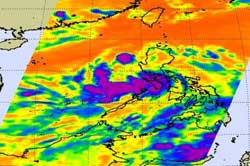NASA catches system 92W become fifth NW Pacific tropical depression

This image of Tropical Depression 05W in the Northwestern Pacific June 8 at 1741 UTC (1:41 p.m. EDT) from the NASA AIRS instrument shows strong thunderstorms (purple) over the southern side of the circulation center. Credit: NASA JPL/Ed Olsen<br>
Tropical Depression 05W (TD05W) also known as Dodong in the Philippines was caught by infrared NASA satellite imagery on June 8 at 1741 UTC (1:41 p.m. EDT).
The infrared data showed some powerful thunderstorms with very cold cloud top temperatures near the threshold of AIRS data of -63 Fahrenheit and -52 Celsius. That indicates the coldest, strongest thunderstorms within the tropical depression. Some of the strongest thunderstorms at that time were over western Luzon and stretched out over the South China Sea.
AIRS microwave imagery today showed that the banding of thunderstorms around the southern edge of the depression had the strongest storms. The storm's convection has decreased today. The decrease in convection is because of an upper-level trough (elongated area) of low pressure to the north that is preventing convection from occurring on the storm's northern side.
At 1500 UTC on June 9, TD05W was about 190 miles northwest of Manila, Philippines near 16.7 North and 118.4 East. It was moving to the north-northwest near 12 knots and had maximum sustained winds near 25 knots with higher gusts. It is now moving toward southern China and is expected to intensify into a tropical storm.
Warnings remain posted in the Philippines as TD05W continues pulling away.
NASA's Hurricane page: www.nasa.gov/hurricane
Media Contact
More Information:
http://www.nasa.govAll latest news from the category: Earth Sciences
Earth Sciences (also referred to as Geosciences), which deals with basic issues surrounding our planet, plays a vital role in the area of energy and raw materials supply.
Earth Sciences comprises subjects such as geology, geography, geological informatics, paleontology, mineralogy, petrography, crystallography, geophysics, geodesy, glaciology, cartography, photogrammetry, meteorology and seismology, early-warning systems, earthquake research and polar research.
Newest articles

A universal framework for spatial biology
SpatialData is a freely accessible tool to unify and integrate data from different omics technologies accounting for spatial information, which can provide holistic insights into health and disease. Biological processes…

How complex biological processes arise
A $20 million grant from the U.S. National Science Foundation (NSF) will support the establishment and operation of the National Synthesis Center for Emergence in the Molecular and Cellular Sciences (NCEMS) at…

Airborne single-photon lidar system achieves high-resolution 3D imaging
Compact, low-power system opens doors for photon-efficient drone and satellite-based environmental monitoring and mapping. Researchers have developed a compact and lightweight single-photon airborne lidar system that can acquire high-resolution 3D…





















